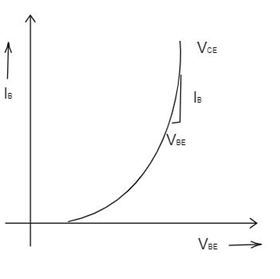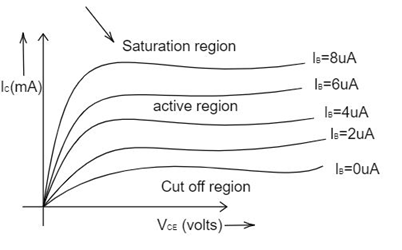Answer
64.8k+ views
Hint: The $n - p - n$ transistor has the input, output and the transfer characteristics. Draw the input characteristics between base current and base emitter voltage and the output characteristics between the collector current and the common emitter voltage.
Complete step by step solution:
(a) The input resistance is also known as input impedance. It is defined as the ratio of the changes in the base emitter voltage to the corresponding change in the base current at a given particular common emitter voltage in the transistor.
The formula of the input impedance is given by
${r_i} = \dfrac{{\Delta {V_{BE}}}}{{\Delta {I_B}}}$ ( at a given ${V_{CE}}$ )
(b) The term current amplification factor is also known as the current gain. It is obtained by dividing the small change in the collector current to that of the corresponding change in the base current of the transistor at constant common emitter voltage.
The formula of the current amplification factor is given by
$\beta = \dfrac{{\Delta {I_C}}}{{\Delta {I_B}}}$ ( at a given ${V_{CE}}$ )
The following graph represents the input characteristics of the $n - p - n$ transistor. It shows that to a certain point, when the base current increases the base emitter voltage remains the same.

The following graph shows the output characteristics of the $n - p - n$ transistor. It includes the cut off, active and the saturated regions of the base current where the common emitter voltage is constant.

Note: In the $n - p - n$ transistor, the $P$ - type of the semiconductor is made connected between the $N$ - type of the semiconductor. It is most commonly used and it looks like the $PN$ junction diode connected back to back. In this transistor, the electron transfers from the base to the collector.
Complete step by step solution:
(a) The input resistance is also known as input impedance. It is defined as the ratio of the changes in the base emitter voltage to the corresponding change in the base current at a given particular common emitter voltage in the transistor.
The formula of the input impedance is given by
${r_i} = \dfrac{{\Delta {V_{BE}}}}{{\Delta {I_B}}}$ ( at a given ${V_{CE}}$ )
(b) The term current amplification factor is also known as the current gain. It is obtained by dividing the small change in the collector current to that of the corresponding change in the base current of the transistor at constant common emitter voltage.
The formula of the current amplification factor is given by
$\beta = \dfrac{{\Delta {I_C}}}{{\Delta {I_B}}}$ ( at a given ${V_{CE}}$ )
The following graph represents the input characteristics of the $n - p - n$ transistor. It shows that to a certain point, when the base current increases the base emitter voltage remains the same.

The following graph shows the output characteristics of the $n - p - n$ transistor. It includes the cut off, active and the saturated regions of the base current where the common emitter voltage is constant.

Note: In the $n - p - n$ transistor, the $P$ - type of the semiconductor is made connected between the $N$ - type of the semiconductor. It is most commonly used and it looks like the $PN$ junction diode connected back to back. In this transistor, the electron transfers from the base to the collector.
Recently Updated Pages
Write a composition in approximately 450 500 words class 10 english JEE_Main

Arrange the sentences P Q R between S1 and S5 such class 10 english JEE_Main

What is the common property of the oxides CONO and class 10 chemistry JEE_Main

What happens when dilute hydrochloric acid is added class 10 chemistry JEE_Main

If four points A63B 35C4 2 and Dx3x are given in such class 10 maths JEE_Main

The area of square inscribed in a circle of diameter class 10 maths JEE_Main

Other Pages
A boat takes 2 hours to go 8 km and come back to a class 11 physics JEE_Main

Electric field due to uniformly charged sphere class 12 physics JEE_Main

In the ground state an element has 13 electrons in class 11 chemistry JEE_Main

According to classical free electron theory A There class 11 physics JEE_Main

Differentiate between homogeneous and heterogeneous class 12 chemistry JEE_Main

Excluding stoppages the speed of a bus is 54 kmph and class 11 maths JEE_Main



